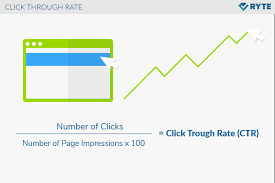
Maximising Click-Through Rate Through Strategic Optimization
The Art of Click-Through Rate Optimization
Click-through rate (CTR) is a crucial metric in the world of online advertising. It measures the percentage of users who click on a specific link or ad out of the total number of impressions it receives. A high CTR indicates that your ad is resonating well with your target audience and driving engagement.
Why CTR Optimization Matters
Optimizing your CTR is essential for several reasons:
- Increased Traffic: A higher CTR means more users are clicking on your ads, leading to increased website traffic.
- Better Quality Score: Search engines like Google consider CTR when determining ad quality scores, which can impact your ad rankings and costs.
- Improved ROI: By improving CTR, you can lower your cost per click (CPC) and increase the return on investment (ROI) of your advertising campaigns.
Tips for Optimizing CTR
Here are some strategies to help you boost your click-through rate:
- Compelling Ad Copy: Write engaging and relevant ad copy that entices users to click. Use strong calls-to-action and highlight unique selling points.
- Targeted Keywords: Use relevant keywords in your ads to ensure they are shown to the right audience. Tailor your messaging based on user intent.
- A/B Testing: Experiment with different ad variations to see which ones perform best. Test elements like headlines, images, and CTAs to find the winning combination.
- Landing Page Optimization: Ensure that your landing pages deliver on the promises made in your ads. A seamless user experience can lead to higher conversion rates.
- Maintain Relevance: Keep your ads relevant to the user’s search query or browsing behaviour. Personalisation can significantly impact CTR.
The Bottom Line
In conclusion, click-through rate optimization is a fundamental aspect of successful online advertising campaigns. By focusing on creating compelling ads, targeting the right audience, testing different strategies, and providing a seamless user experience, you can improve CTR and drive better results for your business.
4.
- 1. What is click-through rate (CTR) and why is it important?
- 2. How can I improve the click-through rate of my online ads?
- 3. What role does ad relevance play in CTR optimization?
- 4. Is A/B testing necessary for optimizing click-through rates?
- 5. How does landing page design impact CTR and what best practices should be followed?
1. What is click-through rate (CTR) and why is it important?
Click-through rate (CTR) is a metric used to measure the percentage of users who click on a specific link or ad out of the total number of impressions it receives. It serves as a key indicator of how engaging and relevant an ad is to its target audience. CTR is crucial in online advertising as it directly impacts the effectiveness of campaigns. A high CTR signifies that the ad is resonating well with users and driving traffic to the intended destination, whether it’s a website, landing page, or product page. By optimising CTR, advertisers can not only increase website traffic but also improve ad performance, lower costs, and ultimately enhance their return on investment (ROI).
2. How can I improve the click-through rate of my online ads?
To enhance the click-through rate of your online ads, several strategies can be employed. Firstly, crafting compelling ad copy that resonates with your target audience and includes a clear call-to-action can significantly boost engagement. Secondly, conducting thorough keyword research to ensure your ads are being shown to the right audience based on their search intent is essential. Additionally, regularly testing different ad variations through A/B testing can help identify what resonates best with users and refine your approach accordingly. Lastly, ensuring a seamless user experience by aligning your ad messaging with the content on your landing page can further encourage users to click through and take desired actions. By implementing these tactics in a cohesive manner, you can effectively improve the click-through rate of your online ads and drive better results for your advertising campaigns.
3. What role does ad relevance play in CTR optimization?
Ad relevance plays a pivotal role in click-through rate (CTR) optimization as it directly influences user engagement and interaction with your ads. When your ads are highly relevant to the user’s search query or browsing intent, they are more likely to attract clicks. By ensuring that your ad copy aligns with the user’s expectations and interests, you can increase the likelihood of capturing their attention and driving them to take action. Ad relevance not only improves CTR but also contributes to a better overall user experience, leading to higher conversion rates and improved campaign performance.
4. Is A/B testing necessary for optimizing click-through rates?
A/B testing plays a crucial role in optimising click-through rates by providing valuable insights into which ad variations resonate best with your target audience. While not strictly necessary, A/B testing allows you to experiment with different elements such as headlines, images, and calls-to-action to identify the most effective combinations. By analysing the performance of these variations, you can make informed decisions to improve CTR and ultimately enhance the overall success of your advertising campaigns.
5. How does landing page design impact CTR and what best practices should be followed?
The design of a landing page plays a significant role in influencing click-through rate (CTR) as it directly affects user engagement and conversion. A well-designed landing page that is visually appealing, easy to navigate, and aligns with the ad’s messaging can positively impact CTR by encouraging users to take the desired action. Best practices for landing page design include maintaining consistency between ad copy and landing page content, ensuring fast loading times, incorporating clear calls-to-action, providing valuable and relevant information, using high-quality visuals, and implementing responsive design for optimal viewing across devices. By following these best practices, businesses can enhance user experience, increase CTR, and ultimately improve the effectiveness of their advertising campaigns.

